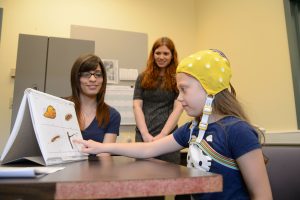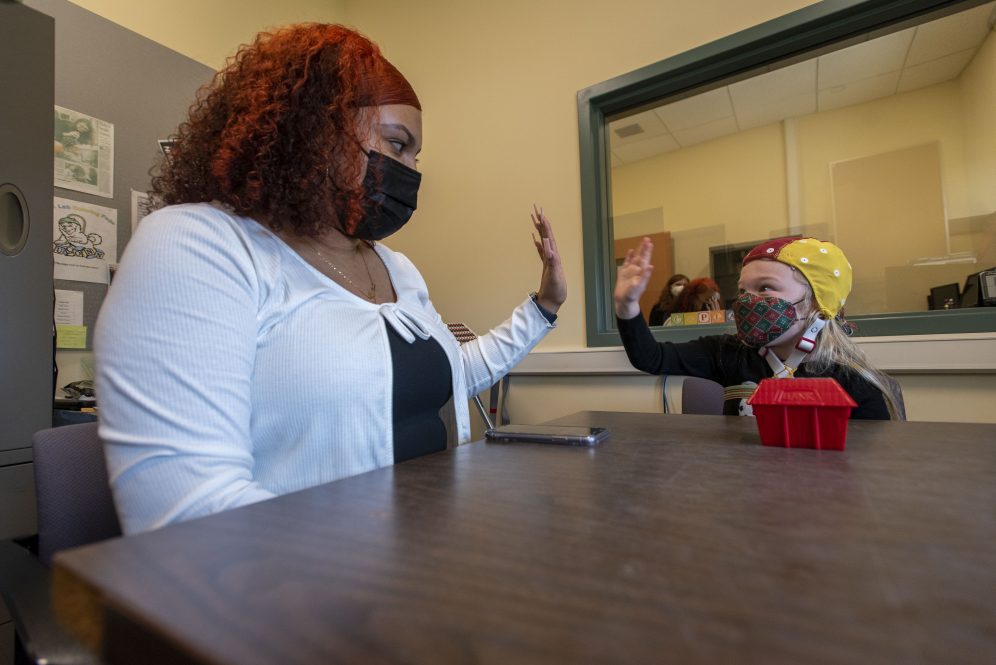Waterbury families in the upcoming “Project Bubbles” are going to become quite familiar with psychological sciences professor Kimberly Cuevas.
The researcher is launching a four-year longitudinal study to better understand child neural development. In the process, over a hundred participants are going to become regular visitors to the Waterbury campus, immersing them in UConn’s resources and environment from an early age.
This summer, Cuevas became the first UConn Waterbury professor to earn a National Institutes of Health (NIH) Research Project Grant Program (R01) award supported by the Eunice Kennedy Shriver National Institute of Child Health and Human Development (NICHD). The awards are highly competitive – only about 10% are funded – and provide support for health-related research and development based on the mission of the NICHD.
The milestone award is representative of the many research opportunities available at the campus, says UConn Waterbury Director Fumiko Hoeft.
“Kimberly is a national leader in research on brain development and learning,” says Hoeft. “We are so lucky to have her as an active faculty member at Waterbury providing students with cutting-edge research opportunities and promoting the UConn goals of increasing research and scholarship as well as providing life transformative education to our students right here on our campus.”
The NIH/NICHD is funding “Project Bubbles” with approximately $3.1 million over the next five years, and the grant is potentially renewable. Cuevas is partnering with researcher Martha Ann Bell at Virginia Tech and Texas A&M on the project, which will include 400 children.

The researchers are seeking better understanding of neural processing during early development. Using electroencephalography (EEG), Cuevas and her team will measure electrical activity in the brain focusing on neural oscillatory rhythms that underlie functions critical to early self-regulation.
Being able to regulate or control our attention, behaviors, and emotions is associated with optimal outcomes across most areas of life. Despite this importance, little is known about how brain activity is linked with regulation during infancy and early childhood. Gathering EEG data on infants and young children is a much more difficult process than later in development. The researchers are determined to provide the first comprehensive and systematic examination of changes in EEG rhythms across infancy and early childhood.
“We want to look at how the brain is changing in individuals over time, starting at six months and then twice a year until they are 4 years old,” Cuevas says. “By doing this repeatedly as they develop, we can not only get glimpses of how things are for a 6-month-old infant but predict things like skills related to kindergarten readiness.”
To collect the data, the infants and children will wear a “swim cap” with sensors that collects EEG from different areas around the scalp. The researchers will measure resting-state EEG by using procedures similar to those with used with adults to get periods of quite attention. For instance, preschoolers sit with their eyes open and closed during a space game. At the same time, they are attempting novel resting-state procedures with infants, such as collecting EEG with the lights on versus the lights off.
As a longitudinal study, the researchers will collect data over an extended developmental period and measure how oscillatory rhythms are changing over time. They hope to determine whether individual differences in neural oscillation measures are related to developmental outcomes, such as cognitive and emotion regulation and broader cognition.
While excited about the scientific implications of the research, Cuevas also believes that the grant opens opportunities for UConn Waterbury students and the surrounding community. UConn Waterbury is a federally designated Minority Serving Institution with a large percentage of first-generation college students.
The funding will support a large research team on campus, creating transformative hands-on experiences for students engaged in all aspects of the research process, including the chance to ask questions and interact with scholars at various points in their careers.
Participants will come from communities at UConn Waterbury and Virginia Tech. In Connecticut, Cuevas and her team plan to cast a wide net for participants, recruiting from UConn KIDS-a contact list of families interested in developmental science at UConn, as well as UConn alum, faculty, staff, and student families. They will also reach out to local preschools, libraries, and other organizations frequented by families with young children.
“We’re going to have the opportunity to develop connections with Waterbury families as we watch their children grow over four years,” Cuevas says. “Maybe some of these babies are going to be our future UConn students!”



